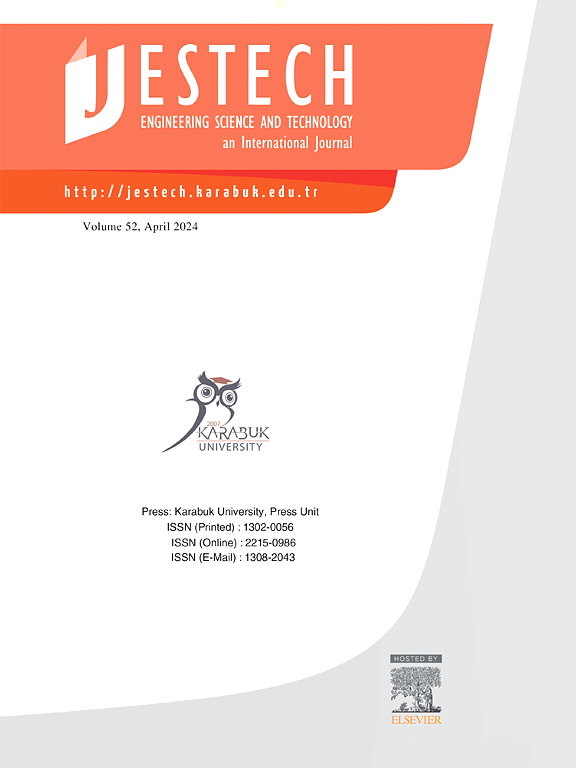基于NLOS分类和误差缓解的超宽带室内定位系统改进
IF 5.4
2区 工程技术
Q1 ENGINEERING, MULTIDISCIPLINARY
Engineering Science and Technology-An International Journal-Jestech
Pub Date : 2025-02-13
DOI:10.1016/j.jestch.2025.101979
引用次数: 0
摘要
在室内定位系统中,非视距(NLOS)条件会显著降低定位精度。尽管超宽带(UWB)技术以其在视距(LOS)环境中的高精度而闻名,但在NLOS条件下,定位误差通常超过30厘米。为了解决这一问题,我们提出了一种基于支持向量机递归特征消除(SVM-RFE)的NLOS信号识别和分类方法。我们从UWB信道脉冲响应(CIR)中提取多个特征,并使用Pearson相关系数(PCC)进行相关分析,通过SVM-RFE算法选择最具判别性的特征。然后在自适应鲁棒扩展卡尔曼滤波器(AREKF)中利用分类结果建立误差模型以进行缓解。使用根特大学的公共数据集和本地收集的数据集对所提出的方法进行了评估。在公共数据集上,SVM-RFE算法在走廊环境下的分类准确率为97.6%,在办公环境下的分类准确率为96.6%,优于在同一数据集上测试的迁移学习(TL)深度神经网络(dnn)。为了进一步验证算法的鲁棒性,在本地采集的办公室数据集上进行的实验表明,分类准确率达到97.2%。在距离测量误差缓解方面,与相同公共数据集上的迁移学习方法相比,所提出的AREKF算法在两种不同环境下将第95百分位的误差减少了70%和75%。通过对局部采集数据集的测试,AREKF的定位误差明显低于其他主流算法,凸显了该方法的实用优势。本文章由计算机程序翻译,如有差异,请以英文原文为准。
Improved UWB-based indoor positioning system via NLOS classification and error mitigation
Non-Line-of-Sight (NLOS) conditions in indoor positioning systems significantly degrade positioning accuracy. Although Ultra-Wideband (UWB) technology is renowned for its high precision in Line-of-Sight (LOS) environments, under NLOS conditions, positioning errors typically exceed 30 cm. To address this issue, we propose a method for identifying and classifying NLOS signals based on Support Vector Machine Recursive Feature Elimination (SVM-RFE). We extract multiple features from the UWB Channel Impulse Response (CIR) and perform correlation analysis using the Pearson Correlation Coefficient (PCC) to select the most discriminative features via the SVM-RFE algorithm. The classification results are then utilized within an Adaptive Robust Extended Kalman Filter (AREKF) to establish an error model for mitigation. The proposed method was evaluated using both a public dataset from Ghent University and a locally collected dataset. On the public dataset, the SVM-RFE algorithm achieved classification accuracies of 97.6% in the hallway environment and 96.6% in the office environment, outperforming transfer learning (TL) deep neural networks (DNNs) tested on the same dataset. To further validate the robustness of the algorithm, experiments on the locally collected office dataset demonstrated a classification accuracy of 97.2%. In terms of distance measurement error mitigation, the proposed AREKF algorithm reduced errors at the 95th percentile by 70% and 75% in two different environments compared to transfer learning methods on the same public dataset. When tested on the locally collected dataset, the positioning error of the AREKF was significantly lower than that of other mainstream algorithms, highlighting the practical advantages of the proposed method.
求助全文
通过发布文献求助,成功后即可免费获取论文全文。
去求助
来源期刊

Engineering Science and Technology-An International Journal-Jestech
Materials Science-Electronic, Optical and Magnetic Materials
CiteScore
11.20
自引率
3.50%
发文量
153
审稿时长
22 days
期刊介绍:
Engineering Science and Technology, an International Journal (JESTECH) (formerly Technology), a peer-reviewed quarterly engineering journal, publishes both theoretical and experimental high quality papers of permanent interest, not previously published in journals, in the field of engineering and applied science which aims to promote the theory and practice of technology and engineering. In addition to peer-reviewed original research papers, the Editorial Board welcomes original research reports, state-of-the-art reviews and communications in the broadly defined field of engineering science and technology.
The scope of JESTECH includes a wide spectrum of subjects including:
-Electrical/Electronics and Computer Engineering (Biomedical Engineering and Instrumentation; Coding, Cryptography, and Information Protection; Communications, Networks, Mobile Computing and Distributed Systems; Compilers and Operating Systems; Computer Architecture, Parallel Processing, and Dependability; Computer Vision and Robotics; Control Theory; Electromagnetic Waves, Microwave Techniques and Antennas; Embedded Systems; Integrated Circuits, VLSI Design, Testing, and CAD; Microelectromechanical Systems; Microelectronics, and Electronic Devices and Circuits; Power, Energy and Energy Conversion Systems; Signal, Image, and Speech Processing)
-Mechanical and Civil Engineering (Automotive Technologies; Biomechanics; Construction Materials; Design and Manufacturing; Dynamics and Control; Energy Generation, Utilization, Conversion, and Storage; Fluid Mechanics and Hydraulics; Heat and Mass Transfer; Micro-Nano Sciences; Renewable and Sustainable Energy Technologies; Robotics and Mechatronics; Solid Mechanics and Structure; Thermal Sciences)
-Metallurgical and Materials Engineering (Advanced Materials Science; Biomaterials; Ceramic and Inorgnanic Materials; Electronic-Magnetic Materials; Energy and Environment; Materials Characterizastion; Metallurgy; Polymers and Nanocomposites)
 求助内容:
求助内容: 应助结果提醒方式:
应助结果提醒方式:


